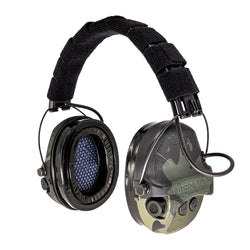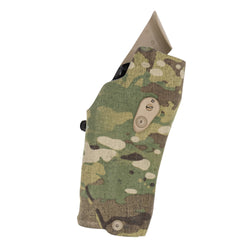I’ve had the pleasure of working in and around the firearms space for the majority of my life at this point, but I hadn’t really ever had the Clamshell explained to me. I was aware of its existence but not much more than that. As part of my quest to continue knowing as much as possible about this industry and its history, I decided to learn about Clamshells. Now it’s time for you to know too — let’s talk about the history of the clamshell holster.

Before we continue, a disclaimer: I have done my best to cross-reference things, but as with a lot of earlier firearms industry “lore,” outside of federal contracts, the history isn’t always super well recorded. But I’ve tried my best to scour the places I can with whatever I can find to cross-reference a complete picture where possible.
What Exactly IS a Clamshell Holster?
The Clamshell is an older design of holster, which you’ll see less of these days, but it plays an important part in the evolution of carry over the years. It’s unique because it’s closer to a case than what we’d consider a holster today. So, like its namesake, it opens up like a clamshell; typically, they’re held together with a latching mechanism, usually adjacent to the trigger well. It pops open a spring, allowing the shooter a clean draw, ready to rock and roll.

Now, before you try to argue semantics with me, I realize Merriam-Webster defines all holsters as “a leather or fabric case for carrying a firearm on the person (as on the hip or chest), on a saddle, or in a vehicle.” But there are already a few things wrong with that. Even the Britannica specifically defines a holster as “a leather case that you wear on your body and that holds a small gun.”
So, basically, I want to start some online beef with dictionaries. That’s entirely too specific for what we’d call a holster today, especially with all the various flavors of polymer and Kydex. So, I think it’s more of a case than a holster!
So Why Carry Clamshell?
With the renaissance of holster design we’re in, we can be spoiled these days. Consider all of the Kydex and other various blends of proprietary polymers that have popped up over the years, artisan hand-made or factory-made leather holsters, the humble cloth holster, and even the 3D printed designs on the horizon.
The modern firearms consumer or someone who needs to carry for work has more options than ever before; it can be hard to imagine a world where the selection was much more limited.

The design offered security, but many designs of the time didn’t quite have the same reliability when it came to accidental release or someone trying to take your gun from you. That latching mechanism might be the only thing that would keep your local junky from taking your gun and making your day worse.
Most of what came before were just little strips of leather that were more for keeping a weapon from jostling than being taken. There was also speed; the spring-loaded aspect mentioned earlier allowed you to draw quickly, given its durability.
Origin of the Design
The Clamshell holster’s unique design is due to Frank C. Jewett, who secured a patent for it in late 1933. The spring-loaded design gained popularity in the mid-1930s and was especially popular in California. The California Highway Patrol and the Los Angeles Police Department (LAPD) were early adopters and used it well into the 1970s.
While, like many of these foundational designs, the design evolved quickly, Jewett’s original design was still close to most of what people used during the Clamshell’s tenure. The original patent was just a pouch holding the gun; it split into two halves with a seam across the front. The rear of the holster was held together by a spring attached to a latching mechanism. All you had to do was push in a button hidden under the leather on the inside of your trigger face. Later designs would play with where this button was, but typically, you’d see them in or around the trigger guard.
There were some other Clamshell types of holsters that would pop up throughout — not nearly as common as the one used by the LAPD, but worth mentioning.
Clamshell Features
We’ve talked about it here and there, but we need to clarify precisely why the Clamshell was so successful for so long. Three distinct factors contributed to its success.
- Security: The clamshell holster’s defining feature was its secure latch. This design prevented most accidental release or unauthorized access to the firearm, which was obviously important for law enforcement, who needed to ensure their weapon was always safely secured.
- Speed: The spring-loaded design of the clamshell holster allowed for a fast draw. With a simple release of the latch, the holster sprang open, presenting the weapon for a smooth and swift draw. This speed was a significant advantage in a gunfight, where every second mattered.
- Durability: Clamshell holsters were typically made from leather and metal. The design warranted this, but it also became an advantage because they’d hold up longer than leather holsters, assuming the mechanism wouldn’t fail.
The Rise & Fall
Despite its initial popularity, the Clamshell holster gradually lost favor within law enforcement circles. This decline can be attributed to several factors. Primarily, simpler holster designs emerged that offered adequate security and speed without the added bulk and complexity of the clamshell mechanism. The Clamshell’s intricate design also required more maintenance than simpler holsters, which may have been another contributing factor to its decline.
There were also some specific examples of Clamshell failing in, albeit specific circumstances that were crucial nonetheless. In the Uncle Scotty Stories hosted by International Tactical, Scotty discussed one of the last times he carried his revolver in one of the holsters. He was in a foot chase with a suspect, and he fell a good distance. He still landed on his feet, but he had hit the ground so hard it activated the spring system in the Clamshell, and his service pistol fell out of the holster into a pool. Anytime you don’t have control over your weapon is a bad time — so this understandably left an impression.
However, the Clamshell holster experienced a brief resurgence in the 1970s. Pop culture likely influenced this renewed interest, particularly in TV shows like “Adam-12,” depicting officers using clamshell holsters. This exposure reintroduced the holster to a broader audience and likely sparked curiosity and interest in this unique piece of law enforcement history.
A Lasting Legacy: The Clamshell Holster Today
Today, they are primarily viewed as vintage or collector’s items, sought after by history buffs who appreciate their unique design and historical significance. Though it has faded from its peak popularity, it was an essential piece of gear in it’s time, made with its own legacy of ingenuity and craftsmanship. It remains an intriguing symbol of a bygone era in law enforcement.
Never forget how important the choice of a good holster is. Special thanks to Mike on Revolverguy.com; his write-up was a great spot to start learning about Clamshell.









